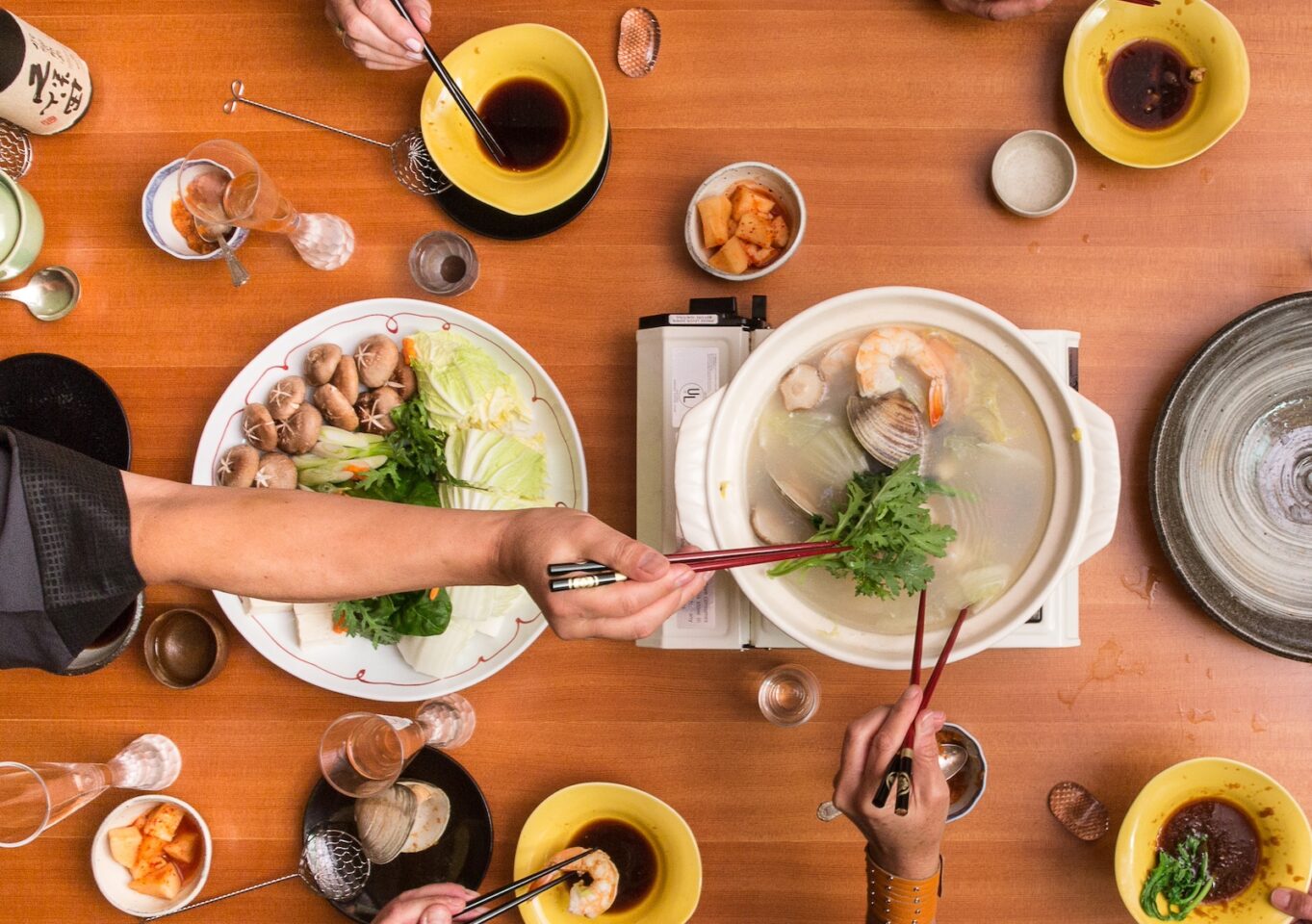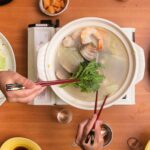Gluten-Free Kaisen Nabe (Japanese Seafood Hot Pot) Recipe

Simply put, Kaisen Nabe is a Japanese seafood hot pot (“Kaisen” means “seafood” and “nabe” means “hot pot.”) But it’s much more than that. It’s a fun, interactive, totally delicious and healthy meal that brings people together for a memorable dining activity.
Here’s how it works: make a yummy broth, put it in the center of the table, ideally with heat under it, and offer platters of seafood and vegetables and let everyone eating it drop items into the broth to cook and then dig them out to eat once they’re cooked through.
Unlike some hot pots, this Kaisen Nabe, by James Beard Award-winning chef Hiro Sone, is gluten-free. The use of gluten-free soy sauce, homemade ponzu sauce (see the recipe below) and a broth made with ingredients are free from gluten, it’s safe and spectacular. So, invite your loved ones over, and let Kaisen Nabe take center stage at your next gathering, showcasing the beauty of Japanese cuisine while accommodating various dietary needs.

Kaisen Nabe (Seafood Hot Pot)
Ingredients
- 1 (3 by 2-inch) piece dashi kombu (dried kelp)
- 1⁄2 small napa cabbage cored and leaves cut into 1 1⁄2-inch wedges
- 1 small carrot peeled, sliced into thin disks, and cut with a mini cookie cutter, if desired
- 12 (1 1⁄2-inch diameter) shiitake mushrooms, stems removed and slits decoratively made on the caps, if desired
- 1 leek white parts only, cleaned and cut diagonally into 1⁄2 by 3-inch pieces, or 2 green onions, cut diagonally into 1⁄2 by 3-inch pieces
- 1 bunch chrysanthemum leaves spinach, or both (about 5 cups)
- 1 1⁄2 pounds skin on boneless lingcod fillet, scales removed and fillet cut into 1-inch slices
- 12 Cherrystone clams or Manila clams
- 16 tail-on deveined shrimp
- 1 recipe Ponzu Sauce see below
- 1⁄2 cup Momiji Oroshi see below
- 2 tablespoons chopped chives
Instructions
-
Place the portable stove in the middle of the dining table and set a shallow 10-inch-wide pot on the burner. Set the table with soup bowls, chopsticks, and small strainers or skimmers, if you have them. Add small side bowls or ramekins for the dipping sauce.
-
Fill a large pot with 8 cups water and the kombu and warm on your kitchen stovetop over medium-low heat to just below boiling, about 20 minutes. Remove and discard the kombu. Keep the broth warm.
-
Meanwhile, arrange the vegetables, mushrooms, and greens on a large platter. Place the seafood on another platter. Pour the Ponzu Sauce into a pitcher. Place the Momiji Oroshi in a small serving bowl. Place the chives in a small serving bowl. Set them on the table.
-
When you’re ready to serve, fill a 10-inch-wide pot on the portable stove with 2 1⁄2 inches of broth. Turn the heat so the broth is just below simmering. In batches, add to the pot items that take the longest to cook: cabbage, carrot, shiitakes, and leek. Once they're cooked, add some seafood to the pot of vegetables, and then the leafy greens.
-
Ask guests to take a serving of dipping sauce and season it with Momiji Oroshi and chives and then invite them to pick out from the cooked food in the pot, dip it in the sauce, and eat it. Be sure to watch the pot, skim any foam from the surface, and continue to add broth, vegetables, and seafood slowly to keep the pot full and hot.
Ponzu Sauce
Ingredients
- 3⁄4 cups rice vinegar
- 3⁄4 cups gluten-free tamari
- 3⁄4 cup mirin rice wine
- 1⁄4 cup homemade Dashi see below or store-bought dashi
- Zest of one lemon
- 1⁄2 cup lemon juice
Instructions
-
Combine the vinegar, tamari, mirin, and dashi in a nonreactive pot and bring it to a boil. Turn off the heat, add the lemon zest and juice, let cool to room temperature, then strain.
Momiji Oroshi (Chile-Spiced Grated Daikon)
Ingredients
- 3⁄4 cup peeled and finely grated daikon radish
- 1⁄8 teaspoon paprika
- 2 pinches cayenne powder
Instructions
-
Place the grated radish in a fine-mesh sieve for 5 to 10 minutes to drain. Transfer the daikon to a small mixing bowl, add the seasonings, mix well, cover, and refrigerate until ready to use.
Recipe Hiro Sone and Lissa Doumani
Photography and Styling Aubrie Pick

